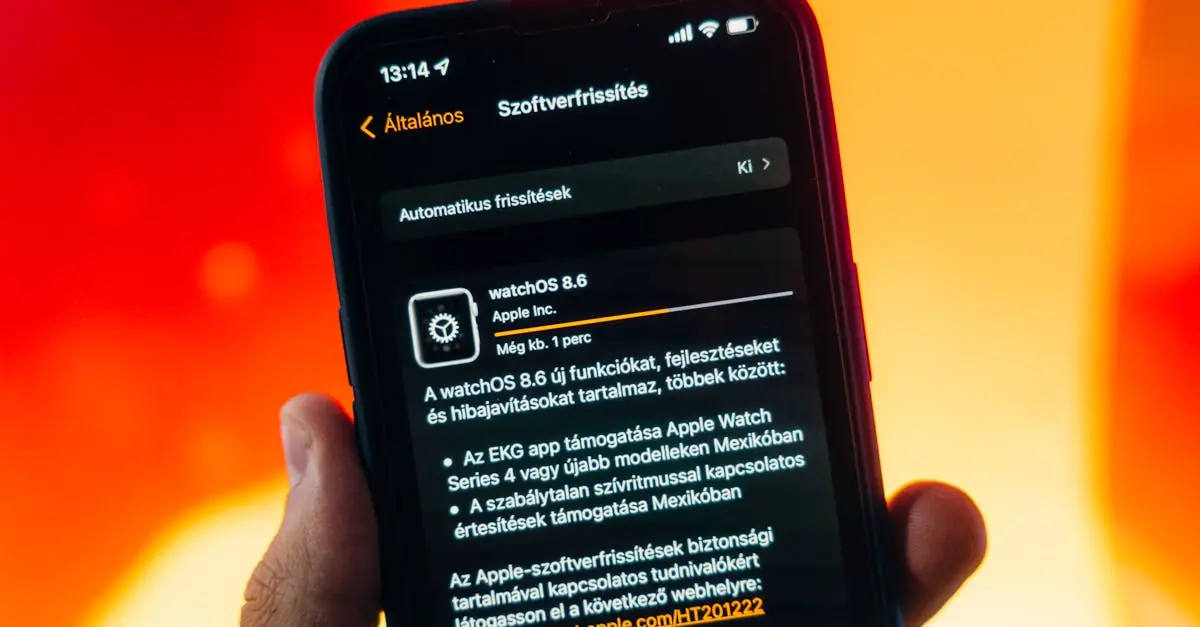Imagine this: you’re scrolling through your favorite app when suddenly, BAM! A red screen pops up, leaving you staring at your iPhone like it just told you a terrible joke. It’s not just annoying; it feels like your device has decided to throw a tantrum. But don’t panic! That red screen isn’t a sign of impending doom; it’s just your iPhone’s way of saying, “Help me!”
Table of Contents
ToggleUnderstanding the Red Screen Issue
The red screen on an iPhone can be disconcerting. Understanding the reasons behind this anomaly can help users troubleshoot effectively.
Common Causes of Red Screen
Hardware malfunctions often trigger the red screen. Users experiencing overheating issues might find their screens turning red due to temperature fluctuations. Software problems, such as a corrupted app, can also lead to this display issue. Improper updates, particularly failed installations, commonly result in unexpected red screens as well. Additionally, problematic beta software or system bugs may create display errors too.
Symptoms to Identify
Identifying the red screen includes recognizing accompanying symptoms. Users might notice their device freezing while displaying the red screen. In some instances, the iPhone may restart unexpectedly without prior warnings. Distinctive glitches or artifacts on the display might signal deeper issues as well. Users occasionally experience difficulty accessing apps or features, indicating a broader problem within the operating system. Remaining aware of these symptoms aids users in diagnosing the root cause of the red screen effectively.
Troubleshooting the Red Screen
Multiple methods exist for troubleshooting the red screen on an iPhone. Users can start with basic fixes before moving to advanced solutions if issues persist.
Basic Fixes to Try
Restarting the device often resolves the red screen issue. Holding the power and volume buttons until the slide to power off appears can help. After powering off, waiting for about 30 seconds before turning it back on is recommended. Checking for app updates through the App Store may also eliminate potential conflicts. Users should uninstall any recently downloaded apps that might have triggered the screen as well. Connecting to a reliable Wi-Fi network enhances the device’s ability to receive software updates, which may fix underlying issues.
Advanced Solutions
Should basic fixes fail, users can consider advanced solutions. Performing a factory reset resets configurations and deletes all data, addressing software errors effectively. It requires backing up data first, as this action will completely erase the device. Using iTunes or Finder to restore the iPhone to factory settings can also resolve persistent problems. Users encountering continued issues may benefit from entering recovery mode, which allows for more thorough software repair. If these methods don’t work, contacting Apple Support for professional assistance is advisable.
Preventing Future Red Screen Issues
Preventing the red screen on an iPhone requires consistent maintenance and timely updates. Users should implement effective strategies to enhance device stability.
Best Practices for iPhone Maintenance
Regularly cleaning the device enhances performance. Users should avoid exposing their iPhones to extreme temperatures, as overheating can lead to hardware issues. Monitoring battery health also plays a crucial role in preventing problems. Maintaining at least a 20% battery charge helps avoid unexpected shutdowns. Furthermore, users should limit background app activity to ensure smooth operation. Keeping the device in a protective case protects against physical damage that may contribute to display issues.
Software Updates and Compatibility
Staying current with software updates prevents compatibility issues. Apple frequently releases updates that fix bugs and improve performance. Users can enable automatic updates to simplify this process, ensuring installation as soon as they become available. Additionally, it’s wise to check app compatibility with the latest iOS version. Running outdated apps can contribute to conflicts that lead to display issues. Always downloading apps from the official App Store reduces exposure to harmful software, promoting a healthier device operating environment.
When to Seek Professional Help
Recognizing when to seek professional help can prevent further damage to the iPhone. Users might experience persistent issues that troubleshooting methods fail to resolve.
Signs That Indicate a Hardware Issue
Visible signs often indicate hardware problems. Users may notice an unusual device temperature, especially during light usage. A flickering display or constant restarts suggests malfunctioning hardware. Additionally, physical damage like cracks or dents often affects internal components. If the battery depletes rapidly, it points towards potential hardware issues as well. In these instances, professional assessment becomes necessary.
Finding Authorized Repair Services
Locating authorized repair services ensures reliable assistance. Users should visit Apple’s official website to find certified technicians nearby. Authorized service providers often use genuine parts for repairs. Reading customer reviews helps users gauge service quality. Some users prefer contacting Apple Support directly for recommendations. Following up with a Genius Bar appointment can also lead to effective solutions. Opting for authorized repair services preserves device warranties and provides peace of mind.
Dealing with a red screen on an iPhone can be daunting but understanding the issue and knowing how to tackle it makes a significant difference. By following the troubleshooting steps outlined and maintaining the device regularly, users can minimize the chances of encountering this frustrating problem again.
Staying proactive with software updates and being cautious about app downloads will also contribute to a smoother experience. If issues persist despite these efforts seeking professional help is a wise choice. With the right approach and care, users can keep their iPhones running smoothly and avoid future disruptions.




